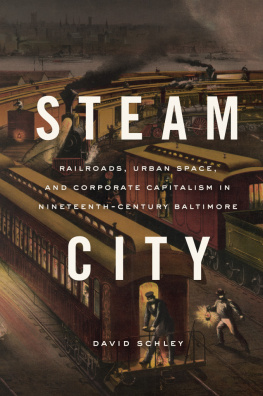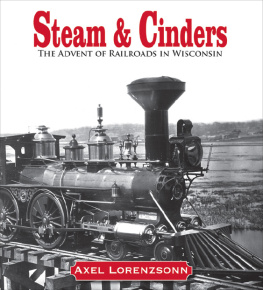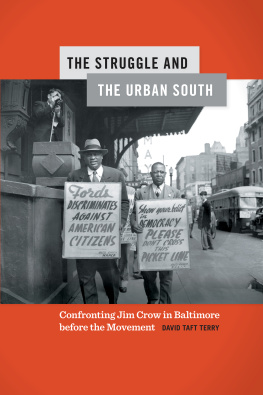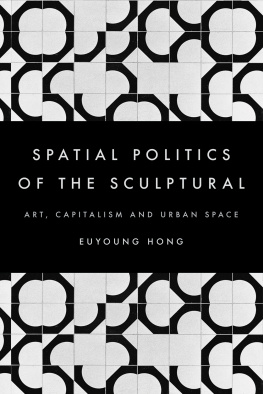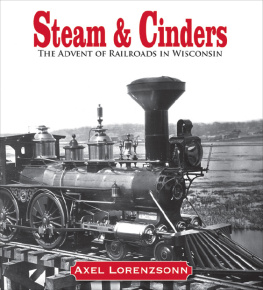David Schley - Steam City: Railroads, Urban Space, and Corporate Capitalism in Nineteenth-Century Baltimore
Here you can read online David Schley - Steam City: Railroads, Urban Space, and Corporate Capitalism in Nineteenth-Century Baltimore full text of the book (entire story) in english for free. Download pdf and epub, get meaning, cover and reviews about this ebook. year: 2020, publisher: University of Chicago Press, genre: Politics. Description of the work, (preface) as well as reviews are available. Best literature library LitArk.com created for fans of good reading and offers a wide selection of genres:
Romance novel
Science fiction
Adventure
Detective
Science
History
Home and family
Prose
Art
Politics
Computer
Non-fiction
Religion
Business
Children
Humor
Choose a favorite category and find really read worthwhile books. Enjoy immersion in the world of imagination, feel the emotions of the characters or learn something new for yourself, make an fascinating discovery.
- Book:Steam City: Railroads, Urban Space, and Corporate Capitalism in Nineteenth-Century Baltimore
- Author:
- Publisher:University of Chicago Press
- Genre:
- Year:2020
- Rating:3 / 5
- Favourites:Add to favourites
- Your mark:
- 60
- 1
- 2
- 3
- 4
- 5
Steam City: Railroads, Urban Space, and Corporate Capitalism in Nineteenth-Century Baltimore: summary, description and annotation
We offer to read an annotation, description, summary or preface (depends on what the author of the book "Steam City: Railroads, Urban Space, and Corporate Capitalism in Nineteenth-Century Baltimore" wrote himself). If you haven't found the necessary information about the book — write in the comments, we will try to find it.
David Schley: author's other books
Who wrote Steam City: Railroads, Urban Space, and Corporate Capitalism in Nineteenth-Century Baltimore? Find out the surname, the name of the author of the book and a list of all author's works by series.
Steam City: Railroads, Urban Space, and Corporate Capitalism in Nineteenth-Century Baltimore — read online for free the complete book (whole text) full work
Below is the text of the book, divided by pages. System saving the place of the last page read, allows you to conveniently read the book "Steam City: Railroads, Urban Space, and Corporate Capitalism in Nineteenth-Century Baltimore" online for free, without having to search again every time where you left off. Put a bookmark, and you can go to the page where you finished reading at any time.
Font size:
Interval:
Bookmark:
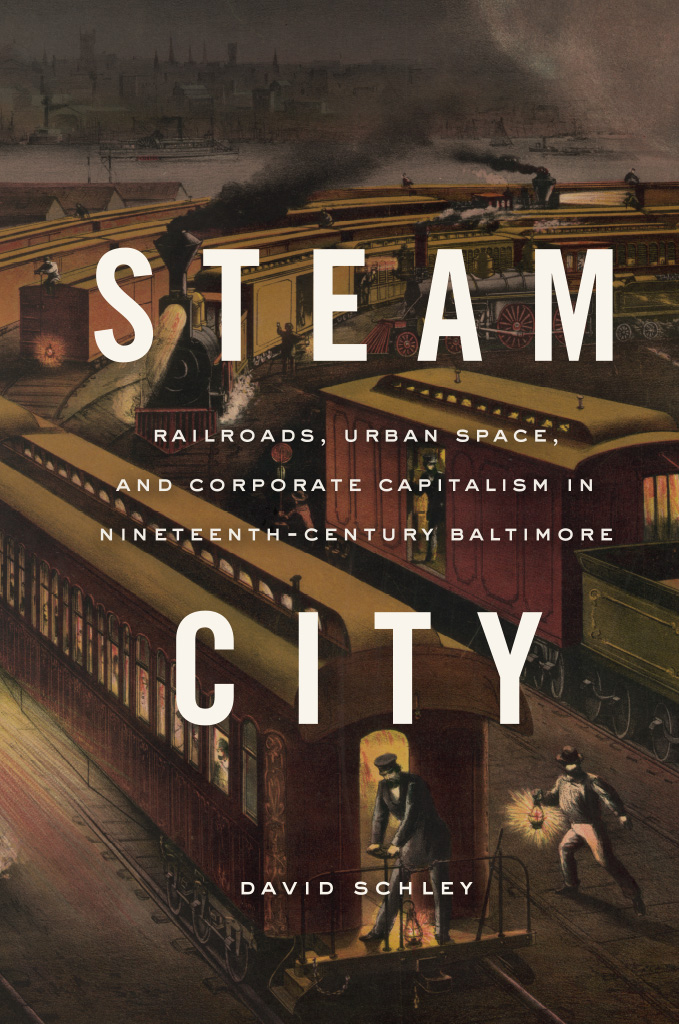

Edited by Lilia Fernndez, Timothy J. Gilfoyle, Becky M. Nicolaides, and Amanda I. Seligman
James R. Grossman, Editor Emeritus
Recent titles in the series
Urban Lowlands: A History of Neighborhoods, Poverty, and Planning
Steven T. Moga
Beyond the Usual Beating: The Jon Burge Police Torture Scandal and Social Movements for Police Accountability in Chicago
Andrew S. Baer
Running the Numbers: Race, Police, and the History of Urban Gambling
Matthew Vaz
The World of Juliette Kinzie: Chicago before the Fire
Ann Durkin Keating
Murder in New Orleans: The Creation of Jim Crow Policing
Jeffrey S. Adler
The Importance of Being Urban: Designing the Progressive School District, 18901940
David A. Gamson
New York Recentered: Building the Metropolis from the Shore
Kara Murphy Schlichting
Renewal: Liberal Protestants and the American City after World War II
Mark Wild
The Gateway to the Pacific: Japanese Americans and the Remaking of San Francisco
Meredith Oda
Bulls Markets: Chicagos Basketball Business and the New Inequality
Sean Dinces
Newsprint Metropolis: City Papers and the Making of Modern Americans
Julia Guarneri
Evangelical Gotham: Religion and the Making of New York City, 17831860
Kyle B. Roberts
Chicagos Block Clubs: How Neighbors Shape the City
Amanda I. Seligman
A complete list of series titles is available on the University of Chicago Press website.
DAVID SCHLEY
The University of Chicago Press
Chicago and London
The University of Chicago Press, Chicago 60637
The University of Chicago Press, Ltd., London
2020 by The University of Chicago
All rights reserved. No part of this book may be used or reproduced in any manner whatsoever without written permission, except in the case of brief quotations in critical articles and reviews. For more information, contact the University of Chicago Press, 1427 E. 60th St., Chicago, IL 60637.
Published 2020
Printed in the United States of America
29 28 27 26 25 24 23 22 21 20 1 2 3 4 5
ISBN-13: 978-0-226-72025-8 (cloth)
ISBN-13: 978-0-226-72039-5 (e-book)
DOI: https://doi.org/10.7208/chicago/9780226720395.001.0001
Library of Congress Cataloging-in-Publication Data
Names: Schley, David, author.
Title: Steam city : railroads, urban space, and corporate capitalism in nineteenth-century Baltimore / David Schley.
Other titles: Historical studies of urban America.
Description: Chicago : University of Chicago Press, 2020. | Series: Historical studies of urban America | Includes bibliographical references and index.
Identifiers: LCCN 2020004121 | ISBN 9780226720258 (cloth) | ISBN 9780226720395 (ebook)
Subjects: LCSH: Baltimore and Ohio Railroad Company. | RailroadsMarylandBaltimoreHistory. | CapitalismMarylandBaltimore.
Classification: LCC HE2781.B35 S35 2020 | DDC 385.09752/6dc23
LC record available at https://lccn.loc.gov/2020004121
 This paper meets the requirements of ANSI / NISO Z39.48-1992 (Permanence of Paper).
This paper meets the requirements of ANSI / NISO Z39.48-1992 (Permanence of Paper).
For Jessica
The railroad age in America kicked off with a grand parade through Baltimore. On the morning of July 4, 1828, thousands of people lined the streets and leaned out of windows to watch a procession of tradesmen, sailors, farmers, and politicians as they marched toward the western fringes of the city, where construction on a new rail-roadthe first of its kind in the United Stateswas to begin. The celebrants anticipated that this enterprise, dubbed the Baltimore & Ohio (B&O) Railroad, would in due course connect their city to the fertile Ohio River valley. First, though, it would have to cross hundreds of miles of mountainous, sparsely populated terrain, an engineering challenge of unprecedented dimensions. To commence work on this audacious project, the companys founders tapped ninety-year-old Charles Carroll of Carrollton, the last living signer of the Declaration of Independence and one of the B&Os principal investors. Carroll sat in a horse-drawn open carriage near the head of the column making its way through the city. He had agreed to dig the first shovelful of earth for the railroad, an act that he asserted to be the second-most important of his life, eclipsed only by his signature of the declaration fifty-two years earlier. When the parade reached the designated site and Carroll sunk his spade into the ground, he inaugurated another kind of revolution.
Nineteenth-century writers recognized the significance of this undertaking immediately. By running fossil-fueled steam engines on straight iron rails, the B&O and the many railroad companies founded in its wake promised to liberate overland travel from the age-old constraints of inclement weather and muscle fatigue. Pundits wrote of the annihilation of time and space as they marveled at the social and economic changes wrought by railroads and other novel modes of communication within their lifetimes. Generations later, these transformations seem no less profound. Historians have documented the important role played by railroad enterprise in the making of industrial capitalism. Whether excoriated as the tools of rapacious robber barons or praised as models of rational organization, railroad companies have long been recognized as the progenitors of the corporate forms and practices that structured the American economy after the Civil War.
In some ways, this end pointthe postbellum rail corporation, its iron bands spanning the continent, its smoking locomotives hauling industrial products, its middle managers coordinating a large and diffused workforce, its bosses cutting backroom deals with congressmenseems prefigured in the ceremony that launched the B&O. Speeches by the fledgling companys leaders in 1828 stressed the power of this new technology to level mountains and shrink the continent, rhetoric that railroad boosters continued to deploy with little modification half a century later. When it came time to break ground, however, the founders revealed a vision for the railroad very different from the modern corporate enterprise it was to become. Carroll did not till the earth to clear space for a rail or a golden spikehe instead made room for a cornerstone, a squat slab of marble embossed with the words FIRST STONE of the BALT & OHIO RAIL ROAD. Inaugurating the company with a cornerstone ceremony figured the B&O as a civic undertaking, akin to a new public building or monument. Even as the railroad prepared to stretch hundreds of miles beyond the city limits, the stone grounded it in Baltimore, marking it as a public initiative with a distinctly urban character.
The B&O was not unique in this regard. Other early railroads, founded in an era wary of corporate power, reflected a limited vision of private enterprise and an expansive vision of urbanism, in which citiesthat is, urban publics acting collectively, often through their mayors and city councilsset in motion initiatives intended to reshape economic geography. At the dawn of the railroad age, writers described the B&O as an urban project, launched by Baltimore, that would bolster the citys lagging economy by capturing a hinterland in the trans-Appalachian West. Boosters from other eastern entreptsPhiladelphia, New York City, Boston, and Charlestonlikewise conceived of railroad corporations as instruments of urban development. In the 1840s, many of these state- and city-sponsored internal improvements failed amid a general depression, and most subsequent railroads incorporated as private enterprises, but even then, the B&O and many other major railroads remained dependent on municipal aid and subscribed to an urban mission.
Next pageFont size:
Interval:
Bookmark:
Similar books «Steam City: Railroads, Urban Space, and Corporate Capitalism in Nineteenth-Century Baltimore»
Look at similar books to Steam City: Railroads, Urban Space, and Corporate Capitalism in Nineteenth-Century Baltimore. We have selected literature similar in name and meaning in the hope of providing readers with more options to find new, interesting, not yet read works.
Discussion, reviews of the book Steam City: Railroads, Urban Space, and Corporate Capitalism in Nineteenth-Century Baltimore and just readers' own opinions. Leave your comments, write what you think about the work, its meaning or the main characters. Specify what exactly you liked and what you didn't like, and why you think so.

